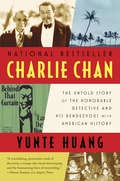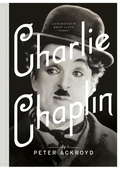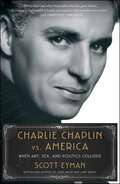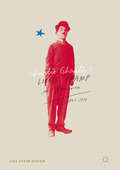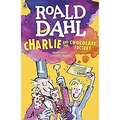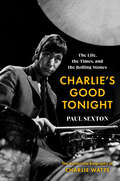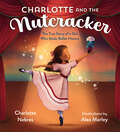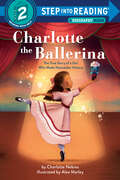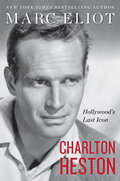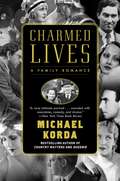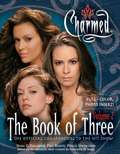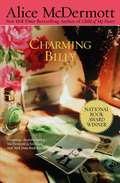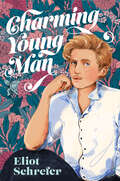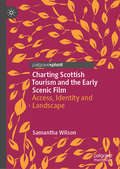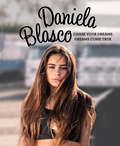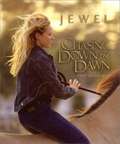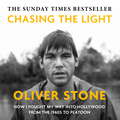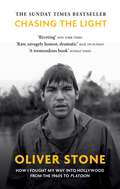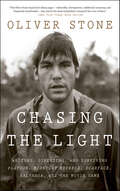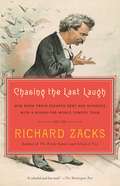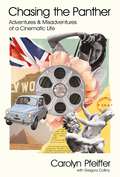- Table View
- List View
Charlie Chan: The Untold Story of the Honorable Detective and His Rendezvous with American History
by Yunte HuangShortlisted for the 2010 National Book Critics Circle Award in Biography and the 2011 Edgar Award for Best Critical/Biographical Book: "An ingenious and absorbing book. . . . It will permanently change the way we tell this troubled yet gripping story."--Jonathan Spence Hailed as "irrepressibly spirited and entertaining" (Pico Iyer, Time) and "a fascinating cultural survey" (Paul Devlin, Daily Beast), this provocative first biography of Charlie Chan presents American history in a way that it has never been told before. Yunte Huang ingeniously traces Charlie Chan from his real beginnings as a bullwhip-wielding detective in territorial Hawaii to his reinvention as a literary sleuth and Hollywood film icon. Huang finally resurrects the "honorable detective" from the graveyard of detested postmodern symbols and reclaims him as the embodiment of America's rich cultural diversity. The result is one of the most critically acclaimed books of the year and a "deeply personal . . . voyage into racial stereotyping and the humanizing force of story telling" (Donna Seaman, Los Angeles Times).
Charlie Chaplin
by N. ChokkanThis book is a biography of Charles Spencer Chaplin globally familiar as "Charlie" Chaplin who was an English comic actor, film director and composer during the silent film era.
Charlie Chaplin
by Peter AckroydA brief yet definitive new biography of one of film's greatest legends: perfect for readers who want to know more about the iconic star but who don't want to commit to a lengthy work.He was the very first icon of the silver screen and is one of the most recognizable of Hollywood faces, even a hundred years after his first film. But what of the man behind the moustache? Peter Ackroyd's new biography turns the spotlight on Chaplin's life as well as his work, from his humble theatrical beginnings in music halls to winning an honorary Academy Award. Everything is here, from the glamor of his golden age to the murky scandals of the 1940s and eventual exile to Switzerland. There are charming anecdotes along the way: playing the violin in a New York hotel room to mask the sound of Stan Laurel frying pork chops and long Hollywood lunches with Mary Pickford and Douglas Fairbanks Jr. This masterful brief biography offers fresh revelations about one of the most familiar faces of the last century and brings the Little Tramp vividly to life.
Charlie Chaplin vs. America: When Art, Sex, and Politics Collided
by Scott EymanThe &“shocking&” (The Wall Street Journal), must-read story of Charlie Chaplin&’s years of exile from the United States during the postwar Red Scare, and how it ruined his film career, from bestselling biographer Scott Eyman.Bestselling Hollywood biographer and film historian Scott Eyman tells the story of Charlie Chaplin&’s fall from grace. In the aftermath of World War II, Chaplin was criticized for being politically liberal and internationalist in outlook. He had never become a US citizen, something that would be held against him as xenophobia set in when the postwar Red Scare took hold. Politics aside, Chaplin had another problem: his sexual interest in young women. He had been married three times and had had numerous affairs. In the 1940s, he was the subject of a paternity suit, which he lost, despite blood tests that proved he was not the father. His sexuality became a convenient way for those who opposed his politics to condemn him. Refused permission to return to the US after a trip abroad, he settled in Switzerland and made his last two films in London. In Charlie Chaplin vs. America, Scott Eyman explores the life and times of the movie genius who brought us such masterpieces as City Lights and Modern Times. &“One of the finest surveys of the man and the artist ever written&” (Leonard Maltin) this book is &“a sobering account of cancel culture in action.&” (The Economist).
Charlie Chaplin’s Little Tramp in America, 1947–77
by Lisa Stein HavenThis book focuses on the re-invigoration of Charlie Chaplin's Little Tramp persona in America from the point at which Chaplin reached the acme of his disfavor in the States, promoted by the media, through his departure from America forever in 1952, and ending with his death in Switzerland in 1977. By considering factions of America as diverse as 8mm film collectors, Beat poets and writers and readers of Chaplin biographies, this cultural study determines conclusively that Chaplin's Little Tramp never died, but in fact experienced a resurgence, which began slowly even before 1950 and was wholly in effect by 1965 and then confirmed by 1972, the year in which Chaplin returned to the United States for the final time, to receive accolades in both New York and Los Angeles, where he received an Oscar for a lifetime of achievement in film.
Charlie and the Chocolate Factory
by Roald DahlThis is an internationally renowned book for children by Roald Dahl. It was first published in 1964 in the USA and later published in 1967 in the UK. Alfred A. Knoff was the first publisher of this book. Dahl has been widely acclaimed for his portrayal of children and their ability to act as adults. This book captures the adventures of Charlie Bucket, who is a poor kid living with his family. Charlie is one of the five kids who gets a golden ticket inside the company, 'Wonka Chocolate' owned by Willy Wonka. Those five kids get an entry inside the Wonka factory. Charlie visits the factory along with his grandfather and gets to experience a lot of adventures inside. The other four kids are later eliminated through hilarious, but painful ways. Will Charlie survive the test? Will he be able to see everything that is to be seen? Readers get a taste of an unusual relationship between a shrewd businessman and a kind kid. In the end, the truth about Wonka is revealed. Why did he host such a competition among kids? The book has all the answers. Dahl was inspired by his own experiences with chocolate companies. At the time When he was in Britain, famous chocolate companies used to send gift boxes to kids in order to complete surveys and win over the market competition. The sweet world of chocolates and the politics that goes into its manufacture is depicted humorously by Dahl through poignant characters. This book was later adapted into feature films as well as documentaries. The movies were very well received by the audience. Kids between the ages of seven to eleven will enjoy this book.
Charlie's Good Tonight: The Life, the Times, and the Rolling Stones: The Authorized Biography of Charlie Watts
by Paul SextonThe fully authorized and official biography of legendary Rolling Stones drummer Charlie Watts, one of the world’s most revered and celebrated musicians of the last half century.Forewords by Mick Jagger and Keith Richards.Charlie Watts was one of the most decorated musicians in the world, having joined the Rolling Stones, a few months after their formation, early in 1963.A student of jazz drumming, he was headhunted by the band after bumping into them regularly in London’s rhythm and blues clubs. Once installed at the drum seat, he didn’t miss a gig, album or tour in his 60 years in the band. He was there throughout the swinging sixties, the early shot at superstardom and the Stones' world conquest; and throughout the debauchery of the 1970s, typified by 1972's Exile on Main St., considered one of the great albums of the century. By the 1980s, Charlie was battling his own demons, but emerged unscathed to enhance his unparalleled reputation even further over the ensuing decades.Watts went through band bust-ups, bereavements and changes in personnel, managers, guitarists and rhythm sections, but remained the rock at the heart of the Rolling Stones for nearly 60 years—the thoughtful, intellectual but no less compelling counterpoint to the raucousness of his bandmates Keith Richards, Mick Jagger and Ronnie Wood. And this is his story.
Charlotte and the Nutcracker: The True Story of a Girl Who Made Ballet History
by Charlotte NebresA reimagined and modern take on the holiday favorite, this picture book weaves together the classic Christmas tale of The Nutcracker and the true-life story of 12-year-old ballerina Charlotte Nebres, the first Black girl to play Marie in the New York City Ballet&’s production.The only thing Charlotte loves as much as ballet is Christmas. So, when she gets the opportunity to play Marie in the New York City Ballet's The Nutcracker, she leaps at the chance. Dancing takes practice-hours of adjusting her arms and perfecting her jumps. With the help of her Trinidadian and Filipino families, encouragement from her sister, and a view of her mom and dad in the audience, Charlotte finds the strength to never give up. In this spectacular debut full of fluid, dynamic illustrations, Charlotte provides youngsters with a multicultural tale of family, dance, and holiday cheer.
Charlotte the Ballerina: The True Story of a Girl Who Made Nutcracker History (Step into Reading)
by Charlotte NebresA reimagined and modern take on the holiday favorite, this picture book weaves together the classic Christmas tale of The Nutcracker and the true-life story of 12-year-old ballerina Charlotte Nebres, the first Black girl to play Marie in the New York City Ballet&’s production.The only thing Charlotte loves as much as ballet is Christmas. So, when she gets the opportunity to play Marie in the New York City Ballet's The Nutcracker, she leaps at the chance. Dancing takes practice-hours of adjusting her arms and perfecting her jumps. With the help of her Trinidadian and Filipino families, encouragement from her sister, and a view of her mom and dad in the audience, Charlotte finds the strength to never give up. In this spectacular debut full of fluid, dynamic illustrations, Charlotte provides youngsters with a multicultural tale of family, dance, and holiday cheer.
Charlton Heston: Hollywood's Last Icon
by Marc EliotThe most definitive biography of Hollywood icon Charlton Heston—one of the most popular, engrossingly complex and, at times, controversial personalities ever to emerge from American cinema.Charlton Heston starred in American movies for more than six decades, in roles that ranged from the Biblical leader Moses in The Ten Commandments to the title role in William Wyler’s definitive Ben-Hur, to the heroic astronaut George Taylor in 1968’s sci-fi classic Planet of the Apes, in addition to hundreds of otherscreen, theater, and television roles. He also served as president of the Screen Actors Guild, and more controversially, as the head of the National Rifle Association, which placed him at odds with Hollywood’s then-prevalent left-leaning power elite.New York Times bestselling author Marc Eliot’s definitive biography, which benefits from extraordinary access to friends, family, and private papers, unravels the epic life story of one of America’s most iconic actors, bringing to light Heston’s greatest achievements as well as his greatest failures and regrets—culminating in an account that is informed, moving, artful, and honest. In it, Eliot lays bare the story of how a boy from the backwoods of Michigan went on to become Hollywood’s go-to action and historical actor and left a legacy that helped define American movie heroes of the twentieth century. From Michigan to New York City to Hollywood, Eliot traces the footsteps of this extraordinary figure and sheds new light on one of America’s greatest stars.In glistening detail, he examines and celebrates the lasting legacy of Charlton Heston, taking advantage of never-before-heard stories of Heston as husband, father, and unremitting actor whose stamp on Hollywood grows stronger every year.
Charmed Lives: A Family Romance
by Michael KordaA Rolls Royce Silver Cloud drove him to airports; the British film industry kowtowed to his power; the great Hollywood studios fawned at his feet. Sir Alexander Korda, one of the world's most flamboyant movie tycoons, rose from obscurity in rural Hungary to become a legendary filmmaker. With him were his brothers, Zoltan and Vincent, all living charmed lives in circles that included H. G. Wells, Sir Lawrence Olivier, Marlena Dietrich, Vivien Leigh, and Merle Oberon, who was soon to be Alex's wife. But along with Alex's flair for success was an equally powerful impulse for destruction. Now, Vincent's son, Michael Korda, in the first book of his memoirs, recalls the enchanted figures of his childhood...the glory days of the Korda brothers' great films...and then their heartbreaking, tragic end.
Charmed: The Book Of Three (Volume Two)
by Diana G. Gallagher Paul Ruditis Phyllis UngerleiderThree sister witches. Two magical sons. One evil ex-husband. Countless demons, baddies, and all-around evildoers vanquished. It all adds up to eight seasons of Charmed, the witchy, wonderful hit television show from Aaron Spelling. This, the second volume of the only authorized companion guide to Charmed, contains everything you need to know about the sexiest supernatural show of all time. Covering seasons six, seven, and eight, the final season, VOLUME 2 lets you inside the enchanted world of Phoebe, Paige, and Piper! Exclusive in-depth interviews with the cast and crew, a prologue by Aaron Spelling, an introduction by executive producer Brad Kern, episode guides, character profiles, and notable quotes.
Charming Billy
by Alice McdermottBilly Lynch's family and friends have gathered at a small Bronx bar. They have come to comfort his widow and to eulogize one of the last great romantics, trading tales of his famous humor, immense charm, and unfathomable sorrow. As they linger on into this extraordinary night, their voices form Billy's tragic story and their mourning becomes a gentle homage to all the lives in their small community fractured by grief, shattered by secrets, and sustained by the simple dream of love.<P><P> National Book Award Winner.
Charming Young Man
by Eliot SchreferFrom New York Times bestselling author Eliot Schrefer comes an exuberant YA historical coming-of-age novel about a rising star French pianist, navigating his way into high society as he explores his sexuality. Perfect for fans of Last Night at the Telegraph Club and The Gentleman’s Gide to Vice and Virtue.They say Léon Delafosse will be France’s next great pianist. But despite his being the youngest student ever accepted into the prestigious Paris Conservatory, there’s no way an impoverished musician can make his way in 1890s Paris without an outside patron.Young gossip columnist Marcel Proust takes Léon under his wing, and the boys game their way through an extravagant new world. When the larger-than-life Count Robert de Montesquiou-Fézensac offers his patronage, Léon’s dreams are made real. But the closer he gets to becoming France’s next great thing, the further he strays from his old country life he shared with his family and his best friend Félix . . . a boy he might love.With each choice Léon makes, he must navigate a fine line between two worlds—or risk losing them both.
Charting Scottish Tourism and the Early Scenic Film: Access, Identity and Landscape
by Samantha WilsonWhat impact did walking tours and scenic films have on leisure activities? In what ways did working class travel disrupt normative narratives concerning nature and identity? The appreciation of nature and leisure travel have a complex and interrelated history in Scotland. In Charting Scottish Tourism, Wilson looks at how scenic filmmaking altered the construction of the tourist map and spatial identities at the turn of the 20th Century. Scenic film, the author argues, played a key role in the expansion of regional travel and national tourism during the period. In addition, scenic film provides the modern researcher with an unrivalled source of documentary evidence relating to the manner in which Scottish working and middle class communities explored and reclaimed the natural spaces around them. The author examines the central role of the Scottish scenic within leisure performances and the way in which these films promoted and challenged normative spatial narratives. These discursive shifts, she argues, had a wide-reaching impact on popular assumptions concerning space, nature and identity both home and away. Charting Scottish Tourism provides a fascinating case study and numerous methodological insights for students and researchers interested in documentary film as well as the construction of identity and the natural world.
Chase your dreams, Dreams come true
by Daniela Blasco«Chase your dreams, dreams come true» es el late motiv de Daniela Blasco, la bailarina y coreógrafa que está revolucionando las redes. Un poco de suerte, un mucho de esfuerzo, y de repente, todo cambió en mi vida. Soy Daniela Blasco, aprendiz de dancer. Hace un tiempo mi vida dio un giro y se llenó de experiencias fantásticas y de gente maravillosa. Me gustaría mucho compartir con todos vosotros todas esas cosas que hacen que mi «pequeño» mundo se transforme en un mundo muy grande, grandísimo, enorme. Un mundo repleto de amistad, amor, risas y, sí, también de esfuerzo, dedicación y sacrificio. ¿Listos para bailar?
Chasin' That Devil Music
by Gayle Dean WardlowThis book explores Mississippi blues: who created it and performed it, how it influenced other blues.
Chasing Down The Dawn: Life Stories
by Jewel KilcherJewel takes her fans on a singular and very personal odyssey through her world, in this beautifully illustrated collection of remembrances, stories, journal entries, drawings, and personal photos. Three 16-page color photo inserts.
Chasing The Light: How I Fought My Way into Hollywood - THE SUNDAY TIMES BESTSELLER
by Oliver Stone*** "A rip-roaring read. It left me breathless." - Chris Evans, Virgin Radio Breakfast Show "Riveting." - The New York Times "... a Hollywood movie in itself." - Spike Lee "Raw, savagely honest, as dramatic as any of his movies." - Mail on Sunday "A tremendous book - readable, funny and harrowing." - The Sunday Times In this powerful and evocative memoir, Oscar-winning director and screenwriter, Oliver Stone, takes us right to the heart of what it's like to make movies on the edge. In Chasing The Light he writes about his rarefied New York childhood, volunteering for combat, and his struggles and triumphs making such films as Platoon, Midnight Express, and Scarface. Before the international success of Platoon in 1986, Oliver Stone had been wounded as an infantryman in Vietnam, and spent years writing unproduced scripts while taking miscellaneous jobs and driving taxis in New York, finally venturing westward to Los Angeles and a new life. Stone, now 73, recounts those formative years with vivid details of the high and low moments: we sit at the table in meetings with Al Pacino over Stone's scripts for Scarface, Platoon, and Born on the Fourth of July; relive the harrowing demon of cocaine addiction following the failure of his first feature, The Hand (starring Michael Caine); experience his risky on-the-ground research of Miami drug cartels for Scarface; and see his stormy relationship with The Deer Hunter director Michael Cimino. We also learn of the breathless hustles to finance the acclaimed and divisive Salvador; and witness tensions behind the scenes of his first Academy Award-winning film, Midnight Express.The culmination of the book is the extraordinarily vivid recreation of filming Platoon in the depths of the Philippine jungle with Kevin Dillon, Charlie Sheen, Willem Dafoe, Johnny Depp et al, pushing himself, the crew and the young cast almost beyond breaking point. Written fearlessly, with intense detail and colour, Chasing the Light is a true insider's story of Hollywood's years of upheaval in the 1970s and '80s, and Stone brings this period alive as only someone at the centre of the action truly can.(P)2020 Octopus Publishing Group
Chasing The Light: How I Fought My Way into Hollywood - THE SUNDAY TIMES BESTSELLER
by Oliver Stone*** "A rip-roaring read. It left me breathless." - Chris Evans, Virgin Radio Breakfast Show "Riveting." - The New York Times "... a Hollywood movie in itself." - Spike Lee "Raw, savagely honest, as dramatic as any of his movies." - Mail on Sunday "A tremendous book - readable, funny and harrowing." - The Sunday Times In this powerful and evocative memoir, Oscar-winning director and screenwriter, Oliver Stone, takes us right to the heart of what it's like to make movies on the edge. In Chasing The Light he writes about his rarefied New York childhood, volunteering for combat, and his struggles and triumphs making such films as Platoon, Midnight Express, and Scarface. Before the international success of Platoon in 1986, Oliver Stone had been wounded as an infantryman in Vietnam, and spent years writing unproduced scripts while taking miscellaneous jobs and driving taxis in New York, finally venturing westward to Los Angeles and a new life. Stone, now 73, recounts those formative years with vivid details of the high and low moments: we sit at the table in meetings with Al Pacino over Stone's scripts for Scarface, Platoon, and Born on the Fourth of July; relive the harrowing demon of cocaine addiction following the failure of his first feature, The Hand (starring Michael Caine); experience his risky on-the-ground research of Miami drug cartels for Scarface; and see his stormy relationship with The Deer Hunter director Michael Cimino. We also learn of the breathless hustles to finance the acclaimed and divisive Salvador; and witness tensions behind the scenes of his first Academy Award-winning film, Midnight Express.The culmination of the book is the extraordinarily vivid recreation of filming Platoon in the depths of the Philippine jungle with Kevin Dillon, Charlie Sheen, Willem Dafoe, Johnny Depp et al, pushing himself, the crew and the young cast almost beyond breaking point. Written fearlessly, with intense detail and colour, Chasing the Light is a true insider's story of Hollywood's years of upheaval in the 1970s and '80s, and Stone brings this period alive as only someone at the centre of the action truly can.
Chasing The Light: Writing, Directing, and Surviving Platoon, Midnight Express, Scarface, Salvador, and the Movie Game
by Oliver Stone“Vulnerable, introspective, stubbornly tenacious and frequently heartbroken — may just be the most sympathetic character [Stone] has ever written.'' —New York Times Book ReviewBefore moving to Los Angeles and the international success of Platoon in 1986, Oliver Stone had been wounded as an infantryman in Vietnam, and spent years writing unproduced scripts while working odd jobs in Manhattan. Stone recounts those formative years with in-the-moment details of the highs and lows: meetings with Al Pacino over Stone’s early scripts; the harrowing demon of cocaine addiction; the failure of his first feature; his risky on-the-ground research of Miami drug cartels for Scarface; and much more. Chasing the Light is a true insider’s guide to Hollywood’s razor-edged years of upheaval in the 1970s and ’80s with untold stories of decade-defining films from the man behind the camera.“Chasing the Light shows a man who still runs towards the gunfire. This is, you will gather, a tremendous book—readable, funny, and harrowing. It’s also full of movie-making gossip, scandal, and fun.” —Sunday Times (London)“Oliver, in honest and sometimes brutal fashion, lays it out — what it took for him to get to where he hoped to be . . . Bravo. Bravo. Bravo.” —Spike Lee, Academy Award-winning director and producer''Oliver Stone is a giant provocateur in the Hollywood movie system. His autobiography is a fascinating exposure of Stone’s inner life and his powerful, all devouring energy and genius that drove him to become one of the world’s greatest filmmakers.” —Sir Anthony Hopkins, a multi-award–winning film actor, director, and producer
Chasing the Last Laugh: Mark Twain's Raucous and Redemptive Round-the-World Comedy Tour
by Richard ZacksFrom Richard Zacks, bestselling author of Island of Vice and The Pirate Hunter, a rich and lively account of how Mark Twain's late-life adventures abroad helped him recover from financial disaster and family tragedy--and revived his world-class sense of humorMark Twain, the highest-paid writer in America in 1894, was also one of the nation's worst investors. "There are two times in a man's life when he should not speculate," he wrote. "When he can't afford it and when he can." The publishing company Twain owned was failing; his investment in a typesetting device was bleeding red ink. After losing hundreds of thousands of dollars back when a beer cost a nickel, he found himself neck-deep in debt. His heiress wife, Livy, took the setback hard. "I have a perfect horror and heart-sickness over it," she wrote. "I cannot get away from the feeling that business failure means disgrace." But Twain vowed to Livy he would pay back every penny. And so, just when the fifty-nine-year-old, bushy-browed icon imagined that he would be settling into literary lionhood, telling jokes at gilded dinners, he forced himself to mount the "platform" again, embarking on a round-the-world stand-up comedy tour. No author had ever done that. He cherry-picked his best stories--such as stealing his first watermelon and buying a bucking bronco--and spun them into a ninety-minute performance. Twain trekked across the American West and onward by ship to the faraway lands of Australia, New Zealand, Tasmania, India, Ceylon, and South Africa. He rode an elephant twice and visited the Taj Mahal. He saw Zulus dancing and helped sort diamonds at the Kimberley mines. (He failed to slip away with a sparkly souvenir.) He played shuffleboard on cruise ships and battled captains for the right to smoke in peace. He complained that his wife and daughter made him shave and change his shirt every day. The great American writer fought off numerous illnesses and travel nuisances to circle the globe and earn a huge payday and a tidal wave of applause. Word of his success, however, traveled slowly enough that one American newspaper reported that he had died penniless in London. That's when he famously quipped: "The report of my death was an exaggeration." Throughout his quest, Twain was aided by cutthroat Standard Oil tycoon H.H. Rogers, with whom he had struck a deep friendship, and he was hindered by his own lawyer (and future secretary of state) Bainbridge Colby, whom he deemed "head idiot of this century." In Chasing the Last Laugh, author Richard Zacks, drawing extensively on unpublished material in notebooks and letters from Berkeley's ongoing Mark Twain Project, chronicles a poignant chapter in the author's life--one that began in foolishness and bad choices but culminated in humor, hard-won wisdom, and ultimate triumph.From the Hardcover edition.
Chasing the Last Laugh: Mark Twain's Raucous and Redemptive Round-the-World Comedy Tour
by Richard ZacksFrom Richard Zacks, bestselling author of Island of Vice and The Pirate Hunter, a rich and lively account of how Mark Twain’s late-life adventures abroad helped him recover from financial disaster and family tragedy—and revived his world-class sense of humorMark Twain, the highest-paid writer in America in 1894, was also one of the nation’s worst investors. “There are two times in a man’s life when he should not speculate,” he wrote. “When he can’t afford it and when he can.” The publishing company Twain owned was failing; his investment in a typesetting device was bleeding red ink. After losing hundreds of thousands of dollars back when a beer cost a nickel, he found himself neck-deep in debt. His heiress wife, Livy, took the setback hard. “I have a perfect horror and heart-sickness over it,” she wrote. “I cannot get away from the feeling that business failure means disgrace.” But Twain vowed to Livy he would pay back every penny. And so, just when the fifty-nine-year-old, bushy-browed icon imagined that he would be settling into literary lionhood, telling jokes at gilded dinners, he forced himself to mount the “platform” again, embarking on a round-the-world stand-up comedy tour. No author had ever done that. He cherry-picked his best stories—such as stealing his first watermelon and buying a bucking bronco—and spun them into a ninety-minute performance. Twain trekked across the American West and onward by ship to the faraway lands of Australia, New Zealand, Tasmania, India, Ceylon, and South Africa. He rode an elephant twice and visited the Taj Mahal. He saw Zulus dancing and helped sort diamonds at the Kimberley mines. (He failed to slip away with a sparkly souvenir.) He played shuffleboard on cruise ships and battled captains for the right to smoke in peace. He complained that his wife and daughter made him shave and change his shirt every day. The great American writer fought off numerous illnesses and travel nuisances to circle the globe and earn a huge payday and a tidal wave of applause. Word of his success, however, traveled slowly enough that one American newspaper reported that he had died penniless in London. That’s when he famously quipped: “The report of my death was an exaggeration.” Throughout his quest, Twain was aided by cutthroat Standard Oil tycoon H.H. Rogers, with whom he had struck a deep friendship, and he was hindered by his own lawyer (and future secretary of state) Bainbridge Colby, whom he deemed “head idiot of this century.” In Chasing the Last Laugh, author Richard Zacks, drawing extensively on unpublished material in notebooks and letters from Berkeley’s ongoing Mark Twain Project, chronicles a poignant chapter in the author’s life—one that began in foolishness and bad choices but culminated in humor, hard-won wisdom, and ultimate triumph.From the Hardcover edition.
Chasing the Panther: Adventures and Misadventures of a Cinematic Life
by Carolyn PfeifferA cinematic and vibrant coming-of-age memoir, Chasing the Panther captures the thrilling and, at times, heartbreaking early years of Carolyn Pfeiffer, a pioneering film producer and one of Hollywood's first female executives—a &“mini-mogul&” in the words of the Wall Street Journal. For a moment in the 1980s, Carolyn Pfeiffer was the only woman in Hollywood who could greenlight a movie. Working with directors like Sam Shepard and Wes Craven, and with actors like River Phoenix and Bette Davis, she had a hand in producing or distributing many landmark films, among them Ridley Scott's The Duellists, Alan Rudolph's Choose Me, and the Academy Award-winning Kiss of the Spider Woman. However, long before establishing herself as a player in the world of film, Carolyn was a horseback-riding tomboy who dreamed of exploring the world beyond her small hometown. Her journey turned out to be a tale fit for the movies.As a young girl jumping from rock to rock in a rural North Carolina town, Carolyn felt a calling she couldn&’t articulate but that she nonetheless understood: it was a tug on her heart, a yearning for something more. When she could, she set out for New York City, a refuge for young women exercising their independence and resisting the pressures of marriage and motherhood. There, swept up in the glamorous world of beat poets and millionaires, Carolyn brushed shoulders with a young Burt Reynolds and became fast friends with an English journalist named Penny. As the turbulent 1960s dawned, Carolyn booked a one-way passage to Europe. Her plan was to visit Penny and to travel around Europe for the summer but, instead, the world opened up to her in ways she never could have imagined. She found herself on set with Italy&’s great filmmakers, in the couture houses of Paris&’ fashion icons, and swept up in the youthful energy flooding London. She learned about film and found work on iconic movies like Federico Fellini&’s 8 ½, Luchino Visconti&’s The Leopard, and David Lean's Doctor Zhivago, and she came to befriend and work alongside luminaries like the Beatles, Tennessee Williams, Francoise Truffaut, and Barbra Streisand. Amid these adventures and misadventures, Carolyn fell in and out of love, and was beset by tragedies and triumphs that resoundingly affirmed what she'd known since girlhood—that she was always destined for something more.Set against the dazzling backdrop of Fellini's Rome, the Paris of the French New Wave, and Swinging London, Chasing the Panther reads like a true-to-life novel revealing Carolyn&’s unforgettable journey to find her place in the world.
Chasing the Rising Sun: The Journey of an American Song
by Edward Mason AnthonyChasing the Rising Sun is the story of an American musical journey told by a prize-winning writer who traced one song in its many incarnations as it was carried across the world by some of the most famous singers of the twentieth century. Most people know the song "House of the Rising Sun" as 1960s rock by the British Invasion group the Animals, a ballad about a place in New Orleans -- a whorehouse or a prison or gambling joint that's been the ruin of many poor girls or boys. Bob Dylan did a version and Frijid Pink cut a hard-rocking rendition. But that barely scratches the surface; few songs have traveled a journey as intricate as "House of the Rising Sun. "The rise of the song in this country and the launch of its world travels can be traced to Georgia Turner, a poor, sixteen-year-old daughter of a miner living in Middlesboro, Kentucky, in 1937 when the young folk-music collector Alan Lomax, on a trip collecting field recordings, captured her voice singing "The Rising Sun Blues. " Lomax deposited the song in the Library of Congress and included it in the 1941 book Our Singing Country. In short order, Woody Guthrie, Pete Seeger, Lead Belly, and Josh White learned the song and each recorded it. From there it began to move to the planet's farthest corners. Today, hundreds of artists have recorded "House of the Rising Sun," and it can be heard in the most diverse of places -- Chinese karaoke bars, Gatorade ads, and as a ring tone on cell phones. Anthony began his search in New Orleans, where he met Eric Burdon of the Animals. He traveled to the Appalachians -- to eastern Kentucky, eastern Tennessee, and western North Carolina -- to scour the mountains for the song's beginnings. He found Homer Callahan, who learned it in the mountains during a corn shucking; he discovered connections to Clarence "Tom" Ashley, who traveled as a performer in a 1920s medicine show. He went to Daisy, Kentucky, to visit the family of the late high-lonesome singer Roscoe Holcomb, and finally back to Bourbon Street to see if there really was a House of the Rising Sun. He interviewed scores of singers who performed the song. Through his own journey he discovered how American traditions survived and prospered -- and how a piece of culture moves through the modern world, propelled by technology and globalization and recorded sound.
